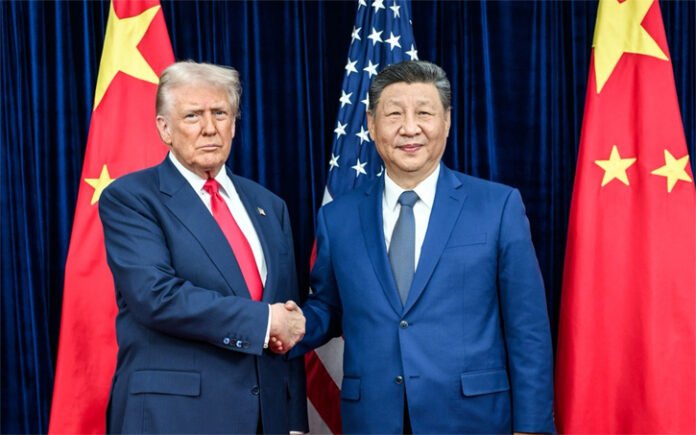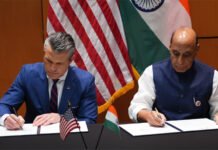
Seoul / Washington DC — November 2, 2025
In a surprise statement that rattled global markets on Saturday, US President Donald Trump said he is considering lifting additional tariffs on China, including those imposed over fentanyl-related exports, if Beijing “fully upholds” its commitments under the newly brokered one-year trade truce.
The announcement came days after the agreement was signed during the US–China–South Korea Economic Forum in Seoul, aimed at cooling years of escalating tariff warfare between the world’s two largest economies.
Trump described the deal as “a test of trust and trade integrity,” while Chinese President Xi Jinping, in his first public comments since the signing, warned against “breaking supply chains” or “using tariffs as weapons of fear.”
The New Truce at a Glance
Under the terms of the Seoul Truce Agreement, both nations agreed to:
Freeze any new tariff increases for one year;
Resume high-level trade dialogues every quarter;
Cooperate on fentanyl precursor controls, a key US demand;
Expand agricultural imports and energy purchases from the US; and
Encourage bilateral technology licensing under “mutual transparency.”
While the pact falls short of a full free-trade accord, officials from both sides hailed it as a “cooling phase”—a crucial step toward rebuilding trust after six years of tit-for-tat tariffs, export bans, and technology blacklists.
Trump’s Offer: “If They Keep Their Word, We’ll Keep Ours”
Speaking to reporters at the White House lawn before flying back from Seoul, Trump said:
“China has made strong promises—big purchases, real fentanyl enforcement, and fairer tech deals. If they keep their word for twelve months straight, we can look at removing extra tariffs, even those tied to narcotics and rare-earth imports.”
The comments sparked immediate debate in Washington and Wall Street. Investors responded positively, with the Dow Jones Industrial Average futures up 1.4% in early trading, while the Shanghai Composite Index surged nearly 3%, its best day in months.
Treasury Secretary Steve Mnuchin Jr. (reappointed for Trump’s second term) later clarified that the tariff removal would depend on a “verified compliance mechanism” involving the World Trade Organization (WTO) and an independent audit panel.
Xi Jinping’s Response: “Supply Chains Must Remain Global”
In Beijing, President Xi addressed Chinese industry leaders and provincial governors, emphasizing restraint and cooperation.
“Breaking supply chains is breaking the future,” Xi warned. “Mutual respect, not economic coercion, should be the foundation of our relations with every partner, including the United States.”
Xi’s remarks, carried by the official Xinhua News Agency, framed the truce as a strategic pause, not an end to the trade struggle. Chinese ministries have been instructed to monitor US compliance and maintain “self-reliance plans” in semiconductor and AI sectors should relations sour again.
Global Markets React with Cautious Optimism
The Seoul accord has eased investor anxiety across Asia. The Korean won strengthened slightly against the US dollar, and crude oil prices rose 2% on renewed optimism for manufacturing demand.
Analysts say the truce’s success hinges on both sides resisting domestic pressure to escalate. Dr. Anita Patel, senior fellow at the Peterson Institute for International Economics, noted:
“Both leaders need a political win—Trump ahead of midterms, Xi facing slowing growth. The truce is mutually beneficial, but fragile.”
Fentanyl Trade at the Center of Negotiations
A major sticking point in recent months has been fentanyl, a synthetic opioid responsible for over 70,000 overdose deaths in the US annually. Washington has accused Chinese suppliers of exporting chemical precursors fueling the crisis.
Beijing has now pledged joint law-enforcement cooperation and enhanced tracking systems for fentanyl-related compounds. In exchange, Washington agreed to review secondary sanctions placed on certain Chinese pharmaceutical exporters and logistics firms.
“This is a diplomatic milestone,” said US Trade Representative Katherine Rogers. “If China truly delivers on fentanyl controls, that’s a win for global health as well as trade.”
Geopolitical Implications
The truce also holds geopolitical weight beyond economics. Seoul’s role as host highlighted South Korea’s emergence as a mediating power in regional diplomacy—balancing alliances with Washington while maintaining strong trade ties with Beijing.
European Union officials cautiously welcomed the development, calling it “a stabilizing moment for the world economy.” Meanwhile, Japan urged both nations to ensure the truce does not “become another cycle of mistrust.”
What Comes Next
Both sides agreed to reconvene in April 2026 to assess progress. The US Commerce Department is preparing a public review of tariff exemptions, while Beijing is fast-tracking new import licenses for American soybeans, liquefied natural gas (LNG), and medical devices.
However, experts warn that political volatility—especially in Washington’s divided Congress—could still derail implementation.
“The truce buys time, not peace,” said economist Li Wei, of Tsinghua University. “Trust must now translate into trade.”
Conclusion
The 2025 US–China trade truce may signal a long-awaited thaw in relations, but both leaders face a test of consistency. Trump’s promise to lift tariffs hinges on verified Chinese cooperation, while Xi’s caution reflects lingering mistrust of US policy reversals.
For global markets, the Seoul agreement is a breath of relief—yet the world’s two largest economies remain entangled in a fragile balance between strategic competition and economic necessity.















